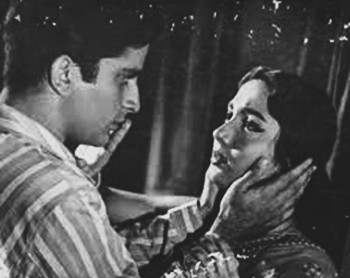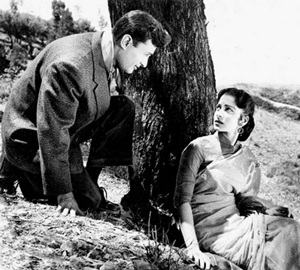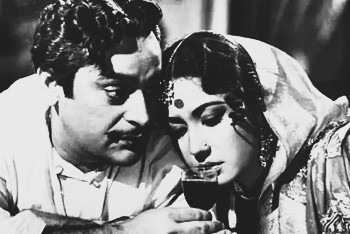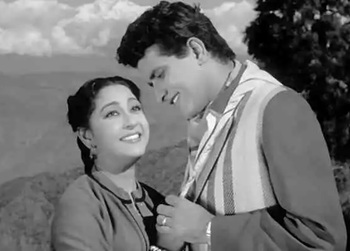Apr 15, 2025
Apr 15, 2025
Continued from the Previous Page
The 1960s – Golden Years – Part 4
The Money Rakers (1960 - 1963) Continued
Prem Patra
 Prem Patra, starring Sadhna and Shashi Kapoor, is about a doctor who is in love with a college mate, but the romance is soured by a misunderstanding. He aspires to go abroad and is forced to get engaged to the daughter of the person who advances funds for his expenses. His betrothed is interested in someone else and, when she gets a letter from her fiancé, she asks the doctor’s beloved, who happens to be her cousin, to reply. While the love letters revive the romance, with the hero assuming that he is writing to his betrothed, a lab accident deprives him of his sight.
Prem Patra, starring Sadhna and Shashi Kapoor, is about a doctor who is in love with a college mate, but the romance is soured by a misunderstanding. He aspires to go abroad and is forced to get engaged to the daughter of the person who advances funds for his expenses. His betrothed is interested in someone else and, when she gets a letter from her fiancé, she asks the doctor’s beloved, who happens to be her cousin, to reply. While the love letters revive the romance, with the hero assuming that he is writing to his betrothed, a lab accident deprives him of his sight.
The present generation may find it difficult to believe that a student had to submit to such conditions to go abroad, but in the 1950s it was indeed tough for middle-class students to find funds to go abroad. There were no easy loans, either from banks or finance companies and most of us had no savings. One of my cousins with a brilliant academic record got admission to an American University but could not raise funds for his ticket. He was about to give up when his professor came to his rescue by sending his ticket as a loan.
Shashi Kapoor was the only one from Prithviraj Kapoor’s family to work in a Bimal Roy film. In 1959, Bimal Roy met young Shashi Kapoor at a talent contest organized by Filmfare, in which Dharmendra was a contestant. Bimal Roy invited them both to Bimal Roy Productions and offered them roles in Prem Patra and Bandini respectively. Shashi Kapoor was already cast in BR Chopra’s Dharmaputra for which he was being paid Rs 25,000. Bimal Roy matched this amount although Shashi Kapoor was a newcomer.
Prem Patra is not one of Bimal Roy’s memorable films. He made it in his usual style, using silences in place of lengthy dialogues, curbing melodrama, and getting the best out of his cast. But the Bimal Roy magic was missing. He seemed to have lost his touch in Prem Patra due to weariness with the system or fatigue.
Due to economic constraints and Bandini's tight shooting schedule, Bimal Roy could not travel to London to take some ambiance shots for Prem Patra. When Bimal Roy learned that Shashi Kapoor was going to England in 1961, he asked him to shoot the scenes, trusting Shashi Kapoor despite his lack of experience in this field. Salil Choudhary’s music for Prem Patra is not one of his best scores, but Mukesh’s Do ankhiyaan jhuki-jhuki si, Talat Mahmood and Lata Mangeshkar’s duet Saawan ki raaton mein, and Talat Mehmood’s Yeh mere andhere ujaale na hote are worth listening to.
 Nav Ketan’s Kala Bazaar, directed by Vijay Anand, and starring Dev Anand and Waheeda Rahman, was the tale of a criminal reformed by love. Dev Anand plays a seller of cinema tickets in black. Because of his dubious occupation, there are shots of him hovering outside a cinema theatre showing Alfred Hitchcock’s North by Northwest, and selling song booklets, outside a theatre showing Talaq, and a star-studded sequence, showing the real-life premiere of Mother India, with famous cinema personalities of the day, Dilip Kumar, Nargis, Nimmi, Kumkum, Mohammad Rafi, Kishore Kumar, Lata Mangeshkar, Guru Dutt, Geeta Dutt, and others. It had good music by SD Burman with Khoya khoya Chand, Rimjhim ke taraane leke aayi barsaat, Sach hue sapne tere, Apni toh har aah ek toofaan hai, Na main dhan chaahoon, and Saanjh dhali dil ki lagi, becoming hits.
Nav Ketan’s Kala Bazaar, directed by Vijay Anand, and starring Dev Anand and Waheeda Rahman, was the tale of a criminal reformed by love. Dev Anand plays a seller of cinema tickets in black. Because of his dubious occupation, there are shots of him hovering outside a cinema theatre showing Alfred Hitchcock’s North by Northwest, and selling song booklets, outside a theatre showing Talaq, and a star-studded sequence, showing the real-life premiere of Mother India, with famous cinema personalities of the day, Dilip Kumar, Nargis, Nimmi, Kumkum, Mohammad Rafi, Kishore Kumar, Lata Mangeshkar, Guru Dutt, Geeta Dutt, and others. It had good music by SD Burman with Khoya khoya Chand, Rimjhim ke taraane leke aayi barsaat, Sach hue sapne tere, Apni toh har aah ek toofaan hai, Na main dhan chaahoon, and Saanjh dhali dil ki lagi, becoming hits.
Following the success of Chaudhvin Ka Chand, Guru Dutt produced another classic. Unfortunately, it was his last film.
Sahib Bibi Aur Ghulam – Another Classic from Guru Dutt
 Sahib Bibi Aur Ghulam, directed by Abrar Alvi, is based on Saheb Bibi Golam (1953) a Bengali novel by Bimal Mitra. Set in the 19th century, it chronicles the decadence of the feudal class, marriage, family, patriarchy, and the zamindari system. At a time when overt sexual expressions were confined to the vamps in Indian cinema, the heroine, instead of spending her time shopping for rich garments and jewellery, consumes alcohol and boldly demands sexual fulfillment from her decadent husband, who deserts her every night to enjoy the company of nautch girls. This character was a departure from the image of an Indian woman that Bollywood maintained until then.
Sahib Bibi Aur Ghulam, directed by Abrar Alvi, is based on Saheb Bibi Golam (1953) a Bengali novel by Bimal Mitra. Set in the 19th century, it chronicles the decadence of the feudal class, marriage, family, patriarchy, and the zamindari system. At a time when overt sexual expressions were confined to the vamps in Indian cinema, the heroine, instead of spending her time shopping for rich garments and jewellery, consumes alcohol and boldly demands sexual fulfillment from her decadent husband, who deserts her every night to enjoy the company of nautch girls. This character was a departure from the image of an Indian woman that Bollywood maintained until then.
Bimal Mitra was an employee in the traffic department of Bengal Nagpur Railway in Bilaspur in the 1940s. He moved to the Control Office in Chakradharpur before he put in his papers in 1950 to pursue a career in writing. One of his novelettes Char Chokher Khela is based on the lives of the Anglo-Indian population of Chakradharpur railway colony. I read Kharida kaudiyon ke daam, a Hindi translation of his Kori Diye Kinlaam in the 1950s. Bimal Mitra was nominated for the Filmfare Award for Best Story for Sahib Bibi Aur Ghulam. During the Centenary celebrations of the South Eastern Railway in 1989-90, Bimal Mitra was felicitated by the Bilaspur Division of the South Eastern Railway.
The story’s title stands for the three main characters, Sahib the younger brother of the Zamindar, played by Rehman, Bibi his wife, aka Chhoti Bahu, played by Meena Kumari, and Ghulam the young Bhootnath, played by Guru Dutt. Guru Dutt considered Shashi Kapoor as the most suitable actor for the role of Bhootnath but dropped the idea when Shashi got unduly late for the appointment. Bengali actor Biswajit Chatterjee, who had assayed the role of Bhootnath in the stage play of the novel, hesitated to accept the role as unsuitable for a debut in Hindi films, eventually appearing in Bees Saal Baad released in the same year which became a top grosser. Guru Dutt took on the role sans his mustache and performed much better than either Shashi Kapoor or Biswajit Chatterjee would have done.
Abrar Alvi initially approached Madhubala and Geeta Bali for the role of Chhoti Bahu. Keen to play the role of Chhoti Bahu, Waheeda Rehman persuaded Guru Dutt and cinematographer VK Murthy for a photo session dressed up as Chhoti Bahu, but after seeing the photographs they decided that she looked too young for the role. She was so keen to be a part of the film that she agreed to play the second lead, despite being an established star in her own right, and gave a memorable performance.
Meena Kumari was impressed with the theme and, hoping that the role would boost her career, persuaded Guru Dutt to accept the high price demanded by her husband Kamal Amrohi. For viewers, it turned out to be a boon because Meena Kumari gave one of the best performances of her career. Meena Kumari takes us deep into the mind of an emotionally and physically cloistered woman. She said that Chhoti Bahu was her twin. When the film did not take off initially, she felt her sister had fallen and injured herself.
The director does not give us a glimpse of the heroine until after fifty minutes, post introduction of minor characters and three songs, while building up our curiosity with the haunting strains of Chale aao chale aao and dialogues about Chhoti Bahu. We see Bhootnath climbing the stairs to her room, his progress interrupted by the Badi Bahu washing her hands for the sixty-third time, and eventually entering the room, his eyes riveted to the floor. We see the floor, the carpet, and her beautiful feet adorned with anklets and toe rings. We hear her voice asking his name, which had, in an earlier sequence, made Waheeda Rehman and others laugh. When she says it is a good name, a startled Bhootnath raises his eyes to look at her and the camera catches her stunning beauty. During the conversation with Bhootnath, Chhoti Bahu expresses her deep anguish in the words Nari jaat ka itna bada apmaan, itni badi lajja. Meena Kumari's histrionics in this scene are priceless.
Guru Dutt wanted SD Burman to score the music and Sahir Ludhianvi to write the lyrics but Burman was unwell and Sahir rejected the offer. Guru Dutt’s next choice was Ravi, whose music score for Chaudhvin Ka Chand (1960) had pleased him, but Ravi suggested his mentor Hemant Kumar since the story was set in Bengal. It was the only time Hemant Kumar provided music for a Guru Dutt film, as a producer or as an actor. VK Murty’s superb choreography captures the mood of the narrative from the first shot which shows a pillar being felled in the ruined Choudhury mansion.
Each of the seven songs in the film is a gem, from the haunting Koi door se awaaz de by Geeta Dutt, the two captivating Geeta Dutt songs filmed on Meena Kumari, Piya aise jiya Mein and Na jao sainya, the light Bhanwra bada naadaan and the sorrowful Meri baat rahi mere man mein sung by Asha Bhonsle filmed on Waheeda Rehman, and the two mujra songs sung by Asha Bhonsle, Meri jaan O meri jaan, filmed on Bimla Kumari and Saqiya Aaj mujhe neend nahin aayegi filmed on Minu Mumtaz. The shooting of the song sequences was directed by Guru Dutt himself, and his style is discernible in them. The light and shadow play in Saqiya Aaj mujhe neend nahin aayegi is a tribute to the director, choreographer, and cinematographer.
The film’s credits show Hemant Kumar as one of the playback singers but there is no song by him in the film. The song Sahil ki taraf recorded for the final sequence with Meena Kumari and Guru Dutt was deleted because the director felt it would have given viewers a wrong notion about the relationship between Chhoti Bahu and Bhootnath. Hemant Kumar reused the tune for Ya dil ki suno in Anupama (1966).
In 1963, the film won the National Film Award for Best Feature Film in Hindi, and at the Filmfare Awards, it won Awards for Best Film, Best Director, Best Actress, and Best Cinematography. Sahib Bibi Aur Ghulam was entered for the 35th American Academy Awards in the Foreign Language Film category but was rejected. Exposing its doublespeak, the Academy wrote that, according to American culture, it was inappropriate for a woman to be an alcoholic! The same Academy had accepted the nomination of Susan Hayward for Best Actress for her performance as an alcoholic in I’ll Cry Tomorrow (1955).
Vijay Bhatt produced two films in this period, namely, Hariyali Aur Rasta, a romantic film, and Angulimal, based on a Buddhist legend.
 Hariyali Aur Rasta was a love triangle, starring Manoj Kumar, Mala Sinha, and Shashikala. The story and characters were stereotyped but good direction combined with a good music score by Shankar Jaikishan helped to make the film successful. This was the first hit film of Manoj Kumar who had made his debut in 1957 in Fashion. Among the popular songs were, Teri Yaad Dil Se Bhulaane Chala Hoon by Mukesh, Allah Jaane Kya Hoga Aage and Bol Meri Taqdeer Mein Kya Hai by Mukesh and Lata Mangeshkar, Yeh Hariyali Aur Yeh Rasta by Lata Mangeshkar. And Kho Gaya Hai Mera Pyar Mahendra Kapoor.
Hariyali Aur Rasta was a love triangle, starring Manoj Kumar, Mala Sinha, and Shashikala. The story and characters were stereotyped but good direction combined with a good music score by Shankar Jaikishan helped to make the film successful. This was the first hit film of Manoj Kumar who had made his debut in 1957 in Fashion. Among the popular songs were, Teri Yaad Dil Se Bhulaane Chala Hoon by Mukesh, Allah Jaane Kya Hoga Aage and Bol Meri Taqdeer Mein Kya Hai by Mukesh and Lata Mangeshkar, Yeh Hariyali Aur Yeh Rasta by Lata Mangeshkar. And Kho Gaya Hai Mera Pyar Mahendra Kapoor.
Angulimal, directed by Vijay Bhatt for the Thai government's Information Service, was adapted from Angulimala Sutta, a story set in the time of Buddha, about the life of the dacoit Angulimaal and his transformation following an encounter with the Buddha. Bharat Bhushan played the leading role with Nimmi and Anita Guha as co-stars. Aayi Aayi Basanti Bela sung by Lata Mangeshkar, Meena Kapoor, and Manna Dey is a classical song well composed by Anil Biswas.
Sasadhar Mukherjee produced three films during this period, Hum Hindustani, Love in Simla, and Ek Musafir Ek Hasina.
Hum Hindustani, directed by Sashadhar Mukherjee’s cousin Ram Mukherjee, is a remake of the 1952 Bengali film Basu Poribar. The leading stars of the film were Sunil Dutt, Joy Mukherjee, and Asha Parekh. Sanjeev Kumar made his debut in the film. The film is about a family which retained their values even in severe distress. Chhodo Kal Ki Baatein sung by Mukesh with music by Usha Khanna was very popular.
Love in Simla was a light musical comedy that marked the debut of several youngsters trained in Filmalaya acting school, including producer Sashadhar Mukherjee’s son Joy Mukherjee, Sadhana, and Azra. Asha Parekh and Sanjeev Kumar were also trained in the Filmalaya Acting school. The film was directed by RK Nayyar and Iqbal Qureshi was the music director. Dar Pe Aaye Hain sung by Mukesh and Haseenon ki sawari sung by Mohammed Rafi were popular.
Ek Musafir Ek Hasina, directed by Raj Khosla, and starring Sadhana and Joy Mukherjee, was a thriller with a complex plot that included the time-worn trick of the hero losing his memory with a bump on his head and regaining it with another bump. It was not one of Raj Khosla’s best suspense films but his association with Sadhana in this film paved the way for some memorable films later. OP Nayyar’s music was an asset for the film. Mohammed Rafi’s Aap Yun Hi Agar Humse Milte Rahe and Mohammed Rafi and Asha Bhonsle’s duets, Bahut Shukriya, Badi Meharbani, and Main Pyar Ka Rahi Hoon are still popular.
Continued to Next Page
15-Feb-2025
More by : Ramarao Annavarapu

|
A really interesting article. I cannot imagine anyone else other than Meena Kumari as Chotti Bahu.. Madhubala, Nutan, Geeta Bali, Nargis...I am sorry I do not think any of these actresses could have done this role. To her credit, Waheeda's role as Jeba was also memorable. I watched Ek Musafir...the songs are great thanks to O P Nayyar and Asha Bhosle but the movie was poorly directed. It was a convoluted plot marked by a chaotic narrative that kept meandering on and on. |

|
Great information shared sir. Thank you very much. In 'Ek Musafir Ek Haseena ' O yaar Zulphowali...' is also a good song. I adored Joy Mukherjee and Sadhana as a teen-ager, though Dev Anand was my ever green hero. |

|
Like many other vintage movies Dev Anands Kala Bazar was a great movie, but Sahib Bibi aur Gulaam was a legend. It is a classic whose echoes reverberate through my soul to this day. The dark and sombre setting, the chilling storyline -- its by all accounts a first rate masterpiece. I hear that the Gaine brothers' mansion in WB where the film was shot still stands. I wonder who are the occupants now .. |

|
Great narrative.i stand amazed at your memory. Thnx |